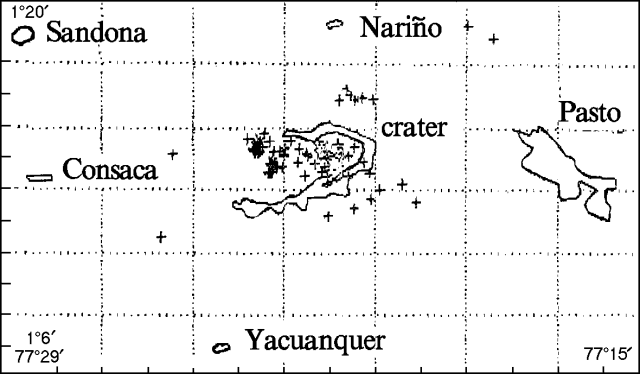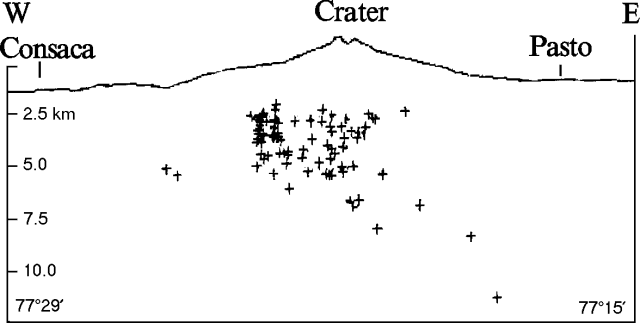Report on Galeras (Colombia) — February 1990
Bulletin of the Global Volcanism Network, vol. 15, no. 2 (February 1990)
Managing Editor: Lindsay McClelland.
Galeras (Colombia) Small ash emissions associated with tremor; moderate seismicity
Please cite this report as:
Global Volcanism Program, 1990. Report on Galeras (Colombia) (McClelland, L., ed.). Bulletin of the Global Volcanism Network, 15:2. Smithsonian Institution. https://doi.org/10.5479/si.GVP.BGVN199002-351080
Galeras
Colombia
1.22°N, 77.37°W; summit elev. 4276 m
All times are local (unless otherwise noted)
Seismicity was at low-moderate levels in February, although substantial seismic energy was released by high-frequency events. The earthquakes were concentrated 2.5 km W of, and beneath the summit crater at 2.5-5.0 km depths (figures 15 and 16). Ash emissions were associated with spasmodic tremor on 3, 8, and 27 February. SO2 emissions reached 5,374 t/d on 10 February, the highest value measured since late October.
 |
Figure 15. Epicenters of 92 high-frequency earthquakes at Galeras, February 1990. Courtesy of INGEOMINAS. |
 |
Figure 16. E-W cross-section at Galeras, showing focal depths of the 92 high-frequency earthquakes in figure 15. Courtesy of INGEOMINAS. |
Geological Summary. Galeras, a stratovolcano with a large breached caldera located immediately west of the city of Pasto, is one of Colombia's most frequently active volcanoes. The dominantly andesitic complex has been active for more than 1 million years, and two major caldera collapse eruptions took place during the late Pleistocene. Long-term extensive hydrothermal alteration has contributed to large-scale edifice collapse on at least three occasions, producing debris avalanches that swept to the west and left a large open caldera inside which the modern cone has been constructed. Major explosive eruptions since the mid-Holocene have produced widespread tephra deposits and pyroclastic flows that swept all but the southern flanks. A central cone slightly lower than the caldera rim has been the site of numerous small-to-moderate eruptions since the time of the Spanish conquistadors.
Information Contacts: INGEOMINAS, Pasto.

